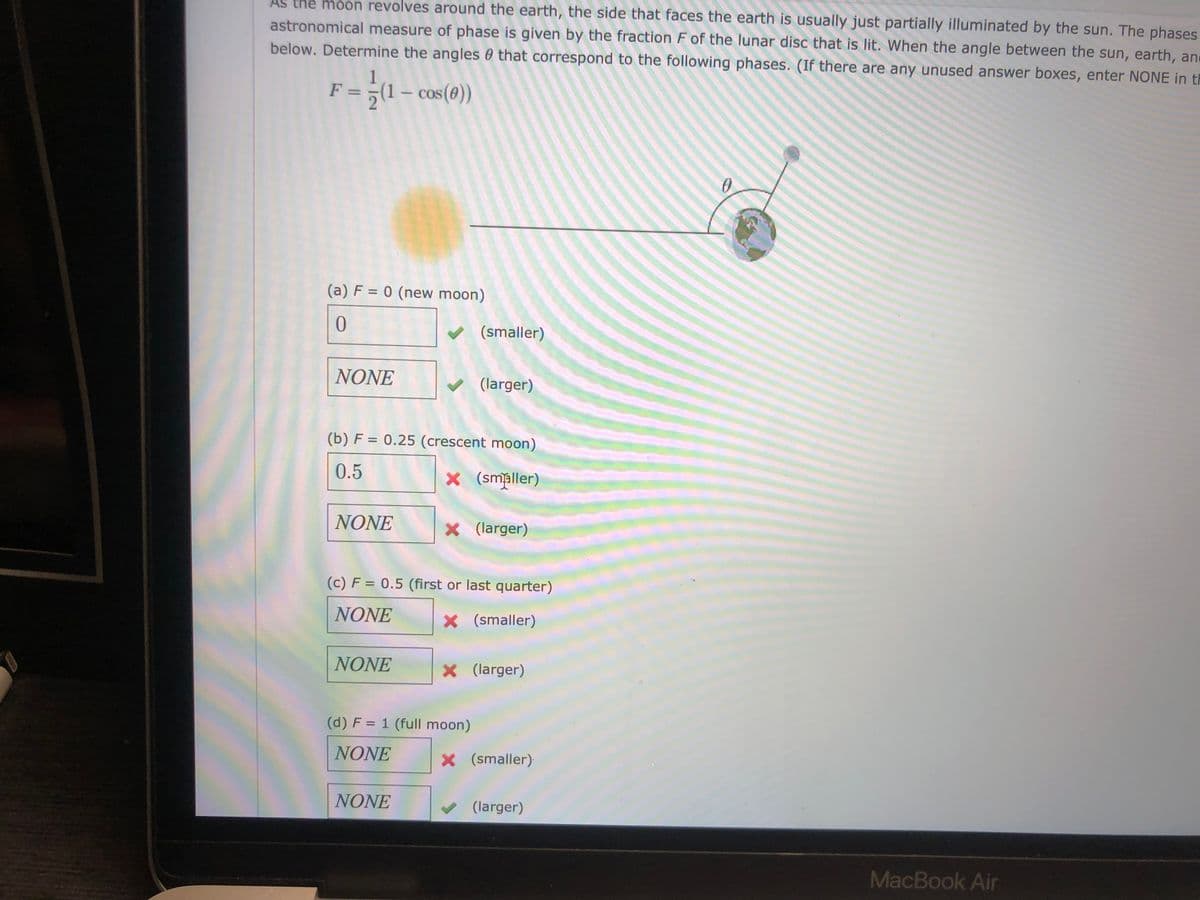AS the moon revolves around the earth, the side that faces the earth is usually just partially illuminated by the sun. The phases astronomical measure of phase is given by the fraction F of the lunar disc that is lit. When the angle between the sun, earth, an- below. Determine the angles that correspond to the following phases. (If there are any unused answer boxes, enter NONE in t F = (1 - cos(e)) 0 (a) F = 0 (new moon) 0 ✔ (smaller) NONE (larger) (b) F= 0.25 (crescent moon) 0.5 X (smaller) NONE X (larger) (c) F = 0.5 (first or last quarter) NONE X (smaller) NONE X (larger) (d) F = 1 (full moon) NONE X (smaller) NONE (larger) MacBook Air
AS the moon revolves around the earth, the side that faces the earth is usually just partially illuminated by the sun. The phases astronomical measure of phase is given by the fraction F of the lunar disc that is lit. When the angle between the sun, earth, an- below. Determine the angles that correspond to the following phases. (If there are any unused answer boxes, enter NONE in t F = (1 - cos(e)) 0 (a) F = 0 (new moon) 0 ✔ (smaller) NONE (larger) (b) F= 0.25 (crescent moon) 0.5 X (smaller) NONE X (larger) (c) F = 0.5 (first or last quarter) NONE X (smaller) NONE X (larger) (d) F = 1 (full moon) NONE X (smaller) NONE (larger) MacBook Air
Algebra & Trigonometry with Analytic Geometry
13th Edition
ISBN:9781133382119
Author:Swokowski
Publisher:Swokowski
Chapter7: Analytic Trigonometry
Section7.3: The Addition And Subtraction Formulas
Problem 60E
Related questions
Question

Transcribed Image Text:moon revolves around the earth, the side that faces the earth is usually just partially illuminated by the sun. The phases
astronomical measure of phase is given by the fraction F of the lunar disc that is lit. When the angle between the sun, earth, and
below. Determine the angles that correspond to the following phases. (If there are any unused answer boxes, enter NONE in th
F = (1 - cos(0))
0
(a) F = 0 (new moon)
0
✓ (smaller)
NONE
(larger)
(b) F = 0.25 (crescent moon)
0.5
X (smaller)
NONE
X (larger)
(c) F = 0.5 (first or last quarter)
NONE
X (smaller)
NONE
X (larger)
(d) F = 1 (full moon)
NONE
X (smaller).
NONE
(larger)
MacBook Air
Expert Solution
This question has been solved!
Explore an expertly crafted, step-by-step solution for a thorough understanding of key concepts.
Step by step
Solved in 5 steps with 5 images

Recommended textbooks for you

Algebra & Trigonometry with Analytic Geometry
Algebra
ISBN:
9781133382119
Author:
Swokowski
Publisher:
Cengage

Algebra & Trigonometry with Analytic Geometry
Algebra
ISBN:
9781133382119
Author:
Swokowski
Publisher:
Cengage